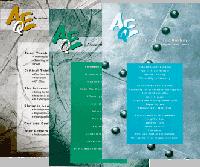Toward a Model of Education

Academic Exchange Quarterly
The following article was published in the Academic Exchange Quarterly during my tenure with the journal as copy editor. Publication information is listed at the end of the essay.
For the last few years there has been a great deal of attention focused on developing a business model for education. In the latest iteration of this model, educators and administrators define employers as their customers, students as their product. Schools have become businesses; teachers, associates.
Part of the pressure behind this re-invention of ourselves and of what we do seems to be a reaction against lecture-based instruction; part of the pressure, the rising interest of private enterprise in education. After all, if schools are just student factories, why shouldn't private industry, with its vast experience in production and marketing, extend its expertise to the business of education?
I suppose at this point you are reacting to that phrase "student factories." But if students are the product of the educational enterprise, then why not "student factories"?
Maybe our resistance to that terminology, with its echoes of Dickens' Hard Times, can remind us that the "business of education" isn't a "business" after all.
Perhaps what we need is to be reminded of the student-teacher model of education.
A student is someone who studies, someone who invests time and energy in learning. Apart from study, nothing can be learned. Too many students think that attendance is unnecessary, that homework is an option, that knowledge is imparted, that the teacher's role is to make them learn, force knowledge into them. Too many students see the teacher as responsible for their learning. It's not that easy. Unlike the products of every business enterprise, students are responsible for students learning.
A teacher is someone who teaches. That is not the same as standing at the front of the classroom and yammering. Teaching is accusatory. It attacks our way of looking at things. The teacher teaches by guiding students in their studies; by sharing the experiences of his or her own studies; by pointing out the alternative path; by marking the dangers along that path and sharing his or her own efforts in negotiating the difficult precipices of learning. The teacher teaches by the art of discrimination, the ability to tell truth from falsehood, good from bad, better from good, the necessary from the expedient, the valid from the specious; by leading students to learn the humility of learning from others, even from those who may not know as much as we know (or think we know).
Perhaps a better path for the future would be for business to model itself after education.
Bill Stifler
Copy Editor
Academic Exchange Quarterly 2.3 (1998): 4.